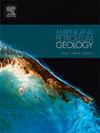伊朗西南部扎格罗斯褶曲-推覆带德兹富勒湾北部的构造风格和变形运动学分析
IF 3.7
2区 地球科学
Q1 GEOSCIENCES, MULTIDISCIPLINARY
引用次数: 0
摘要
全面了解褶皱带和推力带的结构和运动特征可为油气勘探和生产提供重要信息。伊朗西南部扎格罗斯褶皱-推力带的一个重要石油区--德兹富勒海湾北部的三个地下油田(泽洛伊、拉里和卡伦)的运动演化和构造样式利用二维地震数据进行了研究。对由上侏罗世至更新世沉积物组成的深度达 5 千米的二维地震剖面进行了解释,所构建的平衡横断面揭示了油田沿线不同的几何形状和运动学特征。这些结果表明,油田的构造样式分别由作为上层和中层剥离层的 Gachsaran 地层和 Dashtak 地层控制。撕裂断层影响了油田构造风格的沿走向变化。根据对生长地层的分析,从中新世中期开始,褶皱随着肢体的旋转和铰链的迁移而演变。在变形的后期阶段,最初的剥离褶皱转变为断层弯曲褶皱。本文章由计算机程序翻译,如有差异,请以英文原文为准。
Structural style & kinematic analysis of deformation in the northern Dezful Embayment, Zagros Fold-Thrust Belt, SW Iran
A comprehensive understanding of structure and kinematic characteristics of fold and thrust belts provides significant information for hydrocarbon exploration and production. The kinematic evolution and structural style of three subsurface oilfields, Zeloi, Lali and Karun, in the northern part of the Dezful Embayment, a significant petroleum province of the Zagros Fold-Thrust Belt in SW Iran, were investigated using 2D seismic data. Interpretation of the 2D seismic profiles with up to 5 km depth consisting of upper Jurassic to Pleistocene sediments and the balanced cross-sections constructed revealed diverse geometries and kinematics along the oilfields. These results demonstrate that the structural style of the oilfields was controlled by the Gachsaran and Dashtak formations as upper and middle detachment levels, respectively. Tear faults affected the along-strike variations in structural style of the oilfields. Based on the analysis of growth strata, folding evolved as limbs rotated and hinges migrated, beginning in the mid-Miocene. During the later stages of deformation, the initial detachment folds transformed into fault-bend folds.
求助全文
通过发布文献求助,成功后即可免费获取论文全文。
去求助
来源期刊

Marine and Petroleum Geology
地学-地球科学综合
CiteScore
8.80
自引率
14.30%
发文量
475
审稿时长
63 days
期刊介绍:
Marine and Petroleum Geology is the pre-eminent international forum for the exchange of multidisciplinary concepts, interpretations and techniques for all concerned with marine and petroleum geology in industry, government and academia. Rapid bimonthly publication allows early communications of papers or short communications to the geoscience community.
Marine and Petroleum Geology is essential reading for geologists, geophysicists and explorationists in industry, government and academia working in the following areas: marine geology; basin analysis and evaluation; organic geochemistry; reserve/resource estimation; seismic stratigraphy; thermal models of basic evolution; sedimentary geology; continental margins; geophysical interpretation; structural geology/tectonics; formation evaluation techniques; well logging.
 求助内容:
求助内容: 应助结果提醒方式:
应助结果提醒方式:


